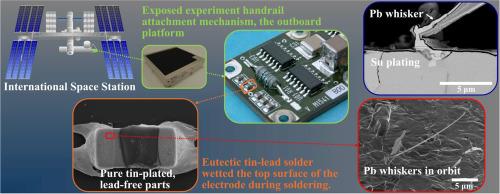Lead whisker growth characteristics on satellites in Earth orbit
IF 2.9
Q2 MATERIALS SCIENCE, MULTIDISCIPLINARY
引用次数: 0
Abstract
This study was undertaken to facilitate the use of lead-free, tin-based, parts in satellites using an exposed experiment handrail attachment mechanism on Kibo, the outboard platform of the International Space Station, and to investigate the growth mechanism of whiskers on satellites in Earth orbit. Pure tin-plated, lead-free parts soldered with a eutectic tin-lead alloy formed lead whiskers in orbit. The lead whiskers were generated specifically from the lead areas on the tin plating of the electrodes owing to the wetting of the solder during soldering. The lead-tin whiskers were also observed on the tin plating. These whiskers were nearly 20 µm long or less; however, their morphology was thin and straight. For comparison with the orbital experiments, thermal cycling tests were performed on the ground in air. The lead-tin whiskers were observed on the ground test samples but were thicker and shorter than those in orbit and were curved. It was confirmed that the growth characteristics of these whiskers in orbit differed from those generated on the ground in air. The presence or absence of oxygen influenced the shape of these whiskers. In addition, striation rings perpendicular to the growth axis were observed on the surface of the whiskers in orbit. This indicates that these whiskers on satellites in orbit were generated by thermal cycling. At the higher temperature of the thermal cycling, the tin grains in tin plating expanded, and the lead in the tin-plated grain boundaries was compressed and squeezed out, leading to the formation of lead whiskers.

地球轨道卫星上铅晶须的生长特性
进行这项研究是为了利用国际空间站舷外平台Kibo上的一种暴露实验扶手附着机构,促进在卫星中使用无铅锡基部件,并研究地球轨道上卫星须的生长机制。用共晶锡铅合金焊接的纯镀锡无铅零件在轨道上形成铅须。由于焊接过程中焊料的润湿,铅须在电极镀锡上的铅区产生。在镀锡层上也观察到铅锡晶须。这些晶须长度接近20微米或更短;但其形态呈细直状。为了与轨道试验进行比较,在地面和空中进行了热循环试验。在地面测试样品上观察到铅锡晶须,但比在轨样品更厚、更短,且呈弯曲状。经证实,这些晶须在轨道上的生长特征不同于在地面上产生的生长特征。氧的存在与否会影响这些晶须的形状。此外,在轨晶须表面还观察到垂直于生长轴的条纹环。这表明在轨卫星上的这些晶须是由热循环产生的。在较高的热循环温度下,镀锡中的锡晶粒膨胀,镀锡晶界中的铅被压缩挤压出,形成铅晶须。
本文章由计算机程序翻译,如有差异,请以英文原文为准。
求助全文
约1分钟内获得全文
求助全文
来源期刊

Materialia
MATERIALS SCIENCE, MULTIDISCIPLINARY-
CiteScore
6.40
自引率
2.90%
发文量
345
审稿时长
36 days
期刊介绍:
Materialia is a multidisciplinary journal of materials science and engineering that publishes original peer-reviewed research articles. Articles in Materialia advance the understanding of the relationship between processing, structure, property, and function of materials.
Materialia publishes full-length research articles, review articles, and letters (short communications). In addition to receiving direct submissions, Materialia also accepts transfers from Acta Materialia, Inc. partner journals. Materialia offers authors the choice to publish on an open access model (with author fee), or on a subscription model (with no author fee).
 求助内容:
求助内容: 应助结果提醒方式:
应助结果提醒方式:


